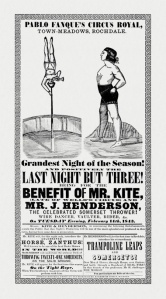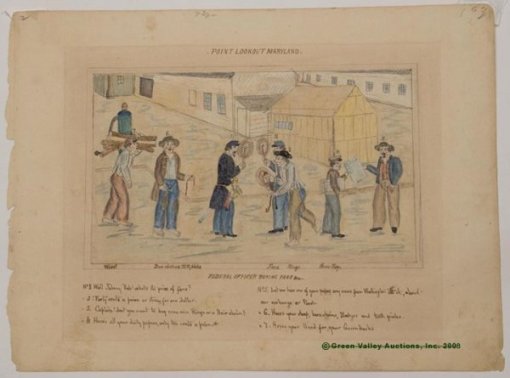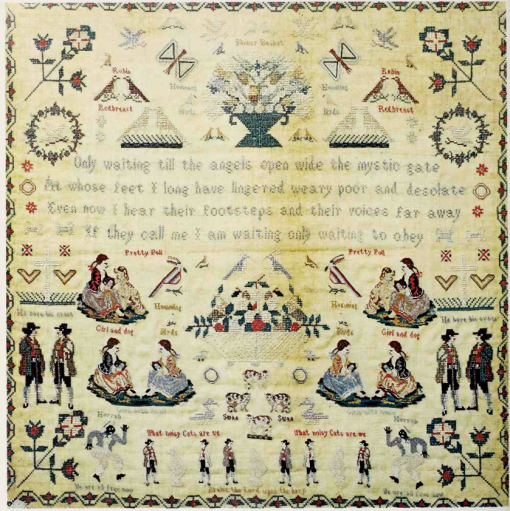Back in the 1980’s I listened to a good deal of R. E. M., the alt band from Georgia (see their official site here.) One of their songs, Swan Swan H from the 1986 album Life’s Rich Pageant, always nagged at me, because I just knew that some of the lyrics had Civil War roots, and I associated them with a piece of artwork I felt I’d seen in a book – it had to be a book; that’s all we had back in the day. First, here’s the band’s performance:
 Searches through my steadily growing Civil War library proved fruitless, and I was unable to find the book in which I saw a piece of folk art by a Confederate POW that included words at least similar to those of songwriter Michael Stipe (that’s him at left, on the cover of the Rolling Stone.)
Searches through my steadily growing Civil War library proved fruitless, and I was unable to find the book in which I saw a piece of folk art by a Confederate POW that included words at least similar to those of songwriter Michael Stipe (that’s him at left, on the cover of the Rolling Stone.)
Then, one day back in January of 2013 I was reading my newsfeed on Facebook. Friend Russell Bonds, author of Stealing the General and War Like the Thunderbolt, (in essence, co-author of this post) had made a brief status update:
A pistol hot cup of rhyme
The whiskey is water, the water is wine
Marching feet, Johnny Reb, what’s the price of heroes?
I immediately recognized these lines from Swan Swan H, and replied with the verse that had afflicted me for a quarter century:
Johnny Reb, what’s the price of fans?
Forty a piece or three for one dollar.
Hey Captain, don’t you want to buy
Some bone chains or toothpicks?
Russ’s post prompted me to dig a little more using Google. Many different search word combinations finally turned up this site, which tells the tale of the conservation of a collection of watercolors made by one John Jacob Omenhauser, titled True Sketches and Sayings of Rebel Characters in the Point Lookout Prison Maryland. At the bottom of that page you’ll see a black and white image of a watercolor sketch. Here’s another, clearer image of that same drawing at this site (thanks Russ), which includes all the illustrations from one of Omenhauser’s sketchbooks:
Apparently there are at least four versions of Omenhauser’s sketchbook. Further search took me to this site, which offered for sale, at one time, a different version of the sketch. Here it is (image courtesy of liveauctioneers.com and Green Valley Auctions) :
In the second version our trio is at center. In both versions you can clearly see the three fans, as well as small chains in the hand of the figure at right. The first two captions/bubbles match the Johnny Reb… stanza above, but the Reb is offering “pretty rings and watch chains” in the first version and “bone rings and hair chains” in the second. It could be that there is another version with “bone chains and toothpicks.”
Mystery solved – in part.
Russ later sent me more information:
OK here you go, Friday detective work diversion from actual work.
Stipe says in an online Q&A interview:
Q: Swan Swan H pretty miraculously spins lyrics in swirls and whirlpools, and any central meaning seems nicely elusive. Could you discuss your views/ intentions/ interpretations of the track? Sometimes I think of redemption/ Christianity; other days its the US South/ slavery/ repression; other days its loneliness. “What’s the price of heroes?” is a line I’ve always enjoyed getting lost in. How does the Swan fit in? Many many thanks – Gary
A (Stipe): civil war song. That’s all I know of writing it, I remember the inspiration but it just flowed. What noisy cats are we I lifted from an actual civil war written piece and Mike and I agreed finally; the title is now Swan Swan Hummingbird. My pretentious 20’s are long gone and we can now all breath a sigh of relief. kind of…
So, I looked in Google Books for “an actual Civil War written piece” that says “what noisy cats are we” and pulled up an issue of Antiques magazine (Vol. 114, p. 559) from 1978 (Lifes Rich Pageant wasn’t released until ’86)—with this listing (partial – the whole book isn’t available on Google):
Note the three Swan Swan H (pronounced “Huh”, according to Stipe) lyrics: noisy cats, hurrah/we are all free, and girl and dog. Hmmm… Originally I thought maybe this was a description of a Howard Finster folk art piece–because of his link to R.E.M. But some further searching led me to a more complete listing of the above that seemed to refer to a sampler by one Elizabeth Jane Hawkes of Salem, NC. I finally found the piece in A Gallery of American Samplers–The Theodore H. Kapnek Collection (E.P. Dutton, 1978), p. 86. The description of the piece is: 123. Elizabeth Jane Hawkes, Salem, North Carolina, c. 1865. Inscription: “Elizabeth Jane Hawkes aged 13, Salem, North Carolina.” Originally noted on former frame. Stitches: cross, tent. Silk on wool, 12 3/4″ h. x 12 3/4″ w. The fascinating thing is the entire first lines of the song are taken directly from the Sampler (see below): “Swan, Swan, Hummingbird, Hurrah, We are all free now. What noisy cats are we, Girl and Dog, He bore His cross.”
Russ found a nice image of the sampler. All of the words and phrases Russ mentioned can be seen in it:
So, here we have what appear to be at least two sources for lyrics to Swan Swan H. And this is where it pays to have an attorney as a friend. Yes, Russ Bonds is an attorney. In Georgia. Where R. E. M. was born. And Russ also happened to know the name of the band’s long-time attorney. He wrote to Mr. Bertis Downs, described our research results up to that point, and then submitted the question:
[We] wanted to be sure to reach out to Michael Stipe and R.E.M. to ask for any comment they might have on this link to the Civil War and Reconstruction era. I know that, in past interviews, the band has often (though not always) declined to discuss song lyrics, stating instead their understandable preference that the songs speak for themselves. But I hope they might make an exception here. After all, these phrases from Swan Swan Hummingbird don’t merely invoke the Civil War era–they were actually spoken/written/sung in that era. I am wondering if Michael Stipe recalls the “actual Civil War written piece” the lyrics were taken from? Was there a book or treatise he referred to? Were the remaining lyrics (e.g. the whiskey is water, the water is wine) from similar sources? Was there someone who first pointed him to these phrases, or to these specific CW-era works of art? Was R.E.M. even aware of these pieces, or are they new to them as well?
Please be assured that we pose these questions out of genuine historic interest, as well as longstanding admiration and respect for R.E.M. Harry and I merely hope to illuminate this connection between R.E.M.’s great music and these beautiful pieces of Civil War art.
Please let me know your thoughts on this issue, and please pass my e-mail along to the members of R.E.M. if you feel that is appropriate. I would welcome hearing from you and/or them on this. Thank you very much for your time and attention.
And, believe it or not, he received a response:
Russell,
Thanks for being in touch– fascinating work.
I checked in with Michael Stipe, who responded with the following:
“These look like the things that I saw and copied down phrases from, forming the basis of the lyric for swan swan h. I remember it was at the american folk art museum in nyc, when it was across the street from either moma[*] or our record company’s hq[**] at the time.
I didn’t remember that there were two pieces that I copied down words from; I remember one piece. But these are almost word for word the lyric of the song; anything else I filled in and wrote myself. These guided me to find the voice for the narrator and go from there.”
Many thanks and good luck with the article and your part-time scholarship.
Kind regards,
Bertis Downs
[*Museum of Modern Art]
[**IRS Records]
How about that?
——————–
John Jacob Omenhauser and Elizabeth Jane Hawkes likely never met. During the American Civil War, John was a Confederate infantryman, while Elizabeth was a North Carolina youth maturing under the difficult circumstances attendant to a country at war. Independently, however, the two produced pieces of folk art that serendipitously made their ways into the lexicon of angst-ridden alt-rock fans in the 1980s.
Some time around 1865, thirteen-year-old Elizabeth, like countless young girls before and after her, painstakingly completed a sampler – needlework embroidery consisting of letters, numbers, words, phrases, and figures. Samplers are examples or tests of one’s skill with needle and thread, and many today are highly valued works of art. Elizabeth’s sampler, a collection of fowl, dancing freedmen (Hurrah We Are All Free Now), cats, dogs, and what would prove to be catchy phrases, made its way over the years into the hands of a collector, and in 1978 it appeared in the pages of A Gallery of American Samplers – the Theodore H. Kapnek Collection.
John was a 30-year-old resident of Richmond, Va. in 1861 when he enlisted in the 46th Virginia Infantry in August, 1861 (the site chronicling the conservation of notebooks says he was an Austrian immigrant, while Mike Musick, his biographer, tells me he was born in Philadelphia.) His service was highlighted by his capture outside Petersburg, Va., in 1864, and his subsequent confinement as a prisoner of war in Camp Lookout, Maryland. While there, or shortly after, John produced at least four hand-made booklets, including water color drawings with captions and “word bubbles,” that are known as True Sketches and Sayings of Rebel Characters in the Point Lookout Prison, Maryland (available as I Am Busy Drawing Pictures: The Civil War Art and Letters of Private John Jacob Omenhausser, CSA, by Ross Kimmel and Michael Musick.) These sketchbooks, like Elizabeth’s sampler, have come to be considered historical and artistic treasures.
 None of this is a criticism of Michael Stipe in any way, shape, or form. Artists take their inspiration where they find it, and while the words and phrases are those of long dead folks, the arrangement of those phrases is Stipe’s alone. And this borrowing from other media isn’t unprecedented by any means. In 1967, the Beatles released Sergeant Pepper’s Lonely Heart’s Club Band, which includes the little ditty Being For the Benefit of Mr. Kite! It’s a rich, psychedelic carnival tune penned mostly by John Lennon with a lot of input from producer George Martin. The source material for the lyrics was provided for the most part by a 19th century poster promoting a carnival act which Lennon had come across in an antique store (see it at left, and read more about it here. Go here to learn about a project reproducing the poster, including information on how to buy one for yourself.) Take a listen, and see if you can find the lyrics in the poster:
None of this is a criticism of Michael Stipe in any way, shape, or form. Artists take their inspiration where they find it, and while the words and phrases are those of long dead folks, the arrangement of those phrases is Stipe’s alone. And this borrowing from other media isn’t unprecedented by any means. In 1967, the Beatles released Sergeant Pepper’s Lonely Heart’s Club Band, which includes the little ditty Being For the Benefit of Mr. Kite! It’s a rich, psychedelic carnival tune penned mostly by John Lennon with a lot of input from producer George Martin. The source material for the lyrics was provided for the most part by a 19th century poster promoting a carnival act which Lennon had come across in an antique store (see it at left, and read more about it here. Go here to learn about a project reproducing the poster, including information on how to buy one for yourself.) Take a listen, and see if you can find the lyrics in the poster:
Mr. Kite has long been a favorite of mine, and sometimes I can’t get the line Messrs. K and H assure the public their production will be second to none out of my head. Just like Johnny Reb, what’s the price of fans?
Can any lyricist ask for more than that?
Below are the full lyrics to what is now titled Swan Swan Hummingbird:
Swan, swan, hummingbird
Hurrah, we are all free now
What noisy cats are we
Girl and dog he bore his cross
Swan, swan, hummingbird
Hurrah, we are all free now
A long, low time ago, people talk to me
Johnny Reb, what’s the price of fans
Forty a piece or three for one dollar?
Hey captain, don’t you want to buy
Some bone chains and toothpicks?
Night wings, her hair chains,
Here’s your wooden greenback, sing
Wooden beams and dovetail sweep
I struck that picture ninety times,
I walked that path a hundred ninety,
Long, low time ago, people talk to me
A pistol hot cup of rhyme
The whiskey is water, the water is wine
Marching feet, Johnny Reb, what’s the price of heroes?
Six in one, half dozen the other,
Tell that to the captain’s mother,
Hey captain, don’t you want to buy,
Some bone chains and toothpicks?
Night wings, her hair chains
Swan, swan, hummingbird
Hurrah, we are all free now
What noisy cats are we
Long, low time ago, people talk to me
A pistol hot cup of rhyme,
The whiskey is water, the water is wine





All this work and it passes with no comments (the bane of the non-confrontational). As a big REM fan during my Jr. High years and beyond, I loved that album but never liked the song enough to look any deeper into possible/apparent CW references. Thanks for this (both of you).
LikeLiked by 1 person
Thanks Drew!
LikeLike
Wow, that’s an impressive amount of research!
LikeLiked by 1 person
Thanks Ellen. Not really that impressive – I mean, it’s not like either of us traveled to some obscure local historical society or anything…
LikeLike
Great research, thanks for sharing! I’ve always loved that song…
LikeLiked by 1 person
Thanks Kennon.
LikeLike
Fantastic work. Fascinating to finally find out the origin of these lyrics.
LikeLike
Thanks, Flor.
LikeLike
Always liked the melody, but the lyrics seemed so elusive to me that I ended up passing over this song. I think it was sort of frustrating to me, like a door that I couldn’t quite unlock. I could feel the tumblers, but it wouldn’t turn. Thanks to you, it turns now. You’ve made this song new to me after 30 years. I’ll never be able to listen to it without these long, long time ago people talking to me as well. So many thanks.
LikeLike
Tim, I’m glad we were able to help you and other REM fans out.
LikeLike
I never knew that. So was John Jacob Omenhauser an immigrant or not?
LikeLike
I’ve not researched it myself, but am willing to take Mike’s word that he was born in Philly – for now.
LikeLike
[…] VA, hipped me to an old song by the band Pavement, which ties together the band R. E. M. (see here for more on them and the Civil War) and First Bull Run participant William T. Sherman. […]
LikeLike
Amazing work. Glad to know the deeper story behind these lyrics. Amazing that they came from people so long ago and reimagined and brought into the modern age.
LikeLiked by 2 people
Thanks, Sylvia!
LikeLike
Great research. This song really should have been on Fables of the Reconstruction!
LikeLiked by 1 person
Nice research, Harry, nicely written! “Life’s Rich Pageant” was the first REM album I ever heard (and immediately became fan) and often wondered what inspired Michael Stipe’s lyrics for this song. You certainly answered that question; kudos!
LikeLike
Thanks John. How’s retirement treating you?
LikeLike
No complaints, but not getting research completed and visiting battle sites like I had planned!
LikeLiked by 1 person
Thank you so much for your painstaking and illuminating research. As a longtime REM fan, I knew there were Civil War roots to the song but could not decipher the deeper meaning. In a similar vein, I once tried to track down United Music World Recording Studios in West Columbia, SC, which got a mention in the “Dead Letter Office” song “The Voice of Harold.” The studios are long gone, but I did find a photo of the Revelaires’ album from which Stipe sang the liner notes.
LikeLike
Laying here in the silence, this song crept into my mind from years ago. Times are so different from when we interpreted lyrics pre-internet, with only the cassette cover to guide us. Thank you for this.
LikeLike
Wow so fascinating. Wonderful post. I love ‘Mr Kite’ too!
LikeLike
Thanks. One of my favorite back in the 90s. Sang along knowing nothing about the civil war, realy – (brought up in an island in the middle of the Atlantic ocean). Something about the thiese cryptic lines to me, the feeling, the atmo, cool lines and the singing, got throug. Great song. Over the years the meaning became a bit clearer. Now clear. Thank you.
LikeLike